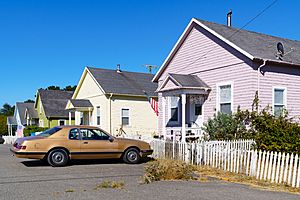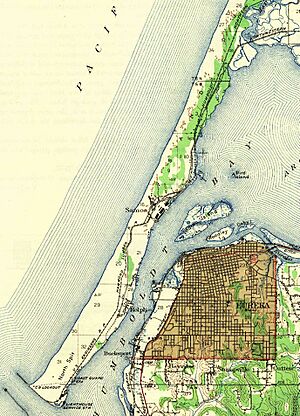Samoa, California facts for kids
Quick facts for kids
Samoa
|
|
|---|---|

Houses in Samoa, August 2020
|
|
| Country | |
| State | |
| County | Humboldt County |
| Area | |
| • Total | 0.837 sq mi (2.167 km2) |
| • Land | 0.837 sq mi (2.167 km2) |
| • Water | 0 sq mi (0 km2) 0% |
| Elevation | 23 ft (7 m) |
| Population
(2020)
|
|
| • Total | 229 |
| • Density | 273.6/sq mi (105.68/km2) |
| Time zone | UTC-8 (Pacific (PST)) |
| • Summer (DST) | UTC-7 (PDT) |
| ZIP code |
95564
|
| Area code(s) | 707 |
| GNIS feature IDs | 1656274; 2628788 |
Samoa, once called Brownsville, is a small community in Humboldt County, California. It's located just northwest of Eureka, right on the northern part of Humboldt Bay. Samoa is famous for the Samoa Cookhouse, which is one of the last old-style lumber camp kitchens still around! The name Samoa is also used for the whole peninsula it sits on. In 2010, about 258 people lived here.
Contents
Why is it Called Samoa?
Samoa got its name in the 1890s because of a big event happening in the Samoan Islands. People thought Samoa's harbor looked a lot like the harbor in Pago Pago in American Samoa. So, they decided to name the town Samoa. Before that, it was called Brownsville. This name came from James D.H. Brown, who owned a dairy farm there in 1859.
Samoa's Early Days
Before people settled here, the northern tip of Humboldt Bay was used for different government projects. These included a lighthouse from 1851 to 1892 and a camp for Native American prisoners during the Bald Hills War in 1862. There was also a life-saving station and a place where stones were prepared for the St. George Reef Light.
The first non-government settler was James Henry Brown, a dairy farmer. He started his ranch in 1865 where Samoa is today. In 1889, a group of businessmen from Eureka formed the Samoa Land and Improvement Company. Then, in 1892, Vance Lumber Company bought land to build a huge sawmill.
The Eureka and Klamath River Railroad was started in 1893. It connected the Samoa sawmill and homes for workers to the city of Arcata and nearby forests. By 1900, the Samoa sawmill was the biggest in Humboldt County. The Samoa post office opened in 1894.
Growth of the Lumber Industry
A factory for making window sashes and doors was added to the mill by 1909. The company became the Hammond Lumber Company in 1912. During World War I, Hammond Lumber Company built a shipyard. They built seven wooden steamships in Samoa between 1917 and 1919.
By 1922, the Samoa area was mainly used for logging. Big companies like Hammond Lumber Company owned most of the land. They used railroads to bring logs and lumber to Samoa from other areas. These railway bridges were destroyed by a wildfire in 1945.
Georgia-Pacific Corporation bought the Samoa sawmill in 1956. They started a plywood mill in 1958. A new, modern sawmill was built in 1964. A pulp mill (which makes paper pulp) started working in 1965. Some old worker homes were torn down, but the Samoa Cookhouse was saved.
Later, the Samoa mill complex was sold to Louisiana-Pacific Corporation in 1972. The last of the old-growth timber was cut in 1980. The area was put up for sale in 2001.
Exploring the Samoa Peninsula
The Samoa Peninsula is a long, narrow strip of land that separates Humboldt Bay from the Pacific Ocean. It's about 10 miles (16 km) long and 1 mile (1.6 km) wide. A channel has been dug to let ships enter the bay. The ends of the jetties (walls that protect the channel) have special concrete blocks called dolos. These blocks look like giant toy jacks and help protect against strong ocean waves.
The peninsula includes the communities of Manila and the Samoa Dunes. These dunes are very important because they have many different kinds of plants and animals. The peninsula is very low, only about 3 feet (0.9 m) above sea level. This means it can be affected by tsunamis. The community of Manila and a United States Coast Guard station are also on the peninsula.
The side of the peninsula facing the ocean is Samoa Beach. In winter, huge waves crash about half a mile offshore. It used to be very hard for sailors to find their way into Humboldt Bay because of the strong currents and frequent fog. Many ships were lost here, earning the area the nickname "graveyard of the Pacific."
Even with lighthouses like the Humboldt Harbor Light, at least 27 ships crashed here before 1917. On January 13, 1917, the warship USS Milwaukee (C-21) got stuck trying to save the submarine USS H-3 (SS-30). The submarine had already been stuck since December 1916. Later, the submarine was moved across the peninsula on rollers and put back into Humboldt Bay.
Samoa's Climate
Samoa has a climate with warm, dry summers. The temperature usually stays below 71.6°F (22°C). Winters are cold and rainy, often with morning fog. This type of weather is called a warm-summer Mediterranean climate.
Who Lives in Samoa?
According to the 2010 census, Samoa had a population of 258 people. Most of the people (76.7%) were White. About 20.2% of the population identified as Hispanic or Latino.
There were 91 households in Samoa. About 30.8% of these households had children under 18 living in them. The average household had about 2.84 people.
See also
 In Spanish: Samoa (California) para niños
In Spanish: Samoa (California) para niños





